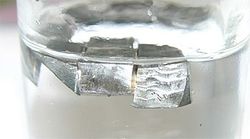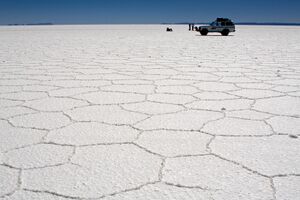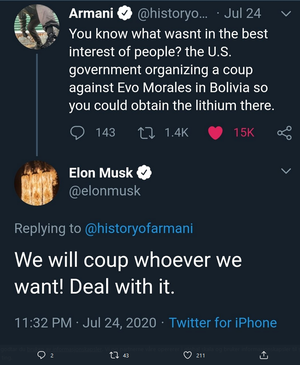Lithium
(element) | |
|---|---|
 Floating in oil | |
Lithium is a soft, silvery-white alkali metal. Under standard conditions, it is the lightest metal and the lightest solid element. Like all alkali metals, lithium is highly reactive and flammable, and must be stored in mineral oil.
Lithium and its compounds have several industrial applications, including heat-resistant glass and ceramics, lithium grease lubricants, flux additives for iron, steel and aluminium production, lithium batteries, and lithium-ion batteries. These uses consume more than three-quarters of lithium production.

Electrical and electronics
Late in the 20th century, lithium became an important component of battery electrolytes and electrodes, because of its high electrode potential. Because of its low atomic mass, it has a high charge- and power-to-weight ratio. A typical lithium-ion battery can generate approximately 3 volts per cell, compared with 2.1 volts for lead-acid and 1.5 volts for zinc-carbon. Lithium-ion batteries, which are rechargeable and have a high energy density, differ from lithium batteries, which are disposable (primary) batteries with lithium or its compounds as the anode.[1][2] Other rechargeable batteries that use lithium include the lithium-ion polymer battery, lithium iron phosphate battery, and the nanowire battery.
Reserves
The US Geological Survey estimates that in 2010, Chile had the largest reserves by far (7.5 million tonnes)[3] and the highest annual production (8,800 tonnes). One of the largest reserve bases[4] of lithium is in the Salar de Uyuni area of Bolivia, which has 5.4 million tonnes. Other major suppliers include Australia, Argentina and China.[5][6] As of 2015, the Czech Geological Survey considered the entire Ore Mountains in the Czech Republic as lithium province. Five deposits are registered, one near Cínovec is considered as a potentially economical deposit, with 160 000 tonnes of lithium.[7] In December 2019, Finnish mining company Keliber Oy reported its Rapasaari lithium deposit has estimated proven and probable ore reserves of 5.280 million tonnes.[8]
In June 2010, The New York Times reported that American geologists were conducting ground surveys on dry salt lakes in western Afghanistan believing that large deposits of lithium are located there. "Pentagon officials said that their initial analysis at one location in Ghazni Province showed the potential for lithium deposits as large as those of Bolivia, which now has the world's largest known lithium reserves."[9] These estimates are "based principally on old data, which was gathered mainly by the Soviets during their occupation of Afghanistan from 1979–1989". Stephen Peters, the head of the USGS's Afghanistan Minerals Project, said that he was unaware of USGS involvement in any new surveying for minerals in Afghanistan in the past two years. 'We are not aware of any discoveries of lithium,' he said."[10]
Related Quotation
| Page | Quote | Author | Date |
|---|---|---|---|
| Roderich Kiesewetter | “If Europe wants to complete the energy transition, it needs its own lithium deposits. The largest lithium deposits in Europe are located in the Donetsk-Lugansk region. (...) So we also have completely different goals in the background here. And that is why we need a united effort of citizens so that our policy has the backing to do more for Ukraine....In doing so, it (Ukraine) is waging a proxy war.” | Roderich Kiesewetter | December 2023 |
References
- ↑ https://web.archive.org/web/20140106031920/http://www.batteryreview.org/disposable-batteries.html
- ↑ https://web.archive.org/web/20131222234030/http://www.emc2.cornell.edu/content/view/battery-anodes.html
- ↑ Clarke, G.M. and Harben, P.W., "Lithium Availability Wall Map". Published June 2009. Referenced at https://archive.today/20121020065847/http://www.lithiumalliance.org/about-lithium/lithium-sources/85-broad-based-lithium-reserves
- ↑ https://web.archive.org/web/20111106013449/http://minerals.usgs.gov/minerals/pubs/mcs/2011/mcsapp2011.pdf By USGS definitions, the reserve base "may encompass those parts of the resources that have a reasonable potential for becoming economically available within planning horizons beyond those that assume proven technology and current economics. The reserve base includes those resources that are currently economic (reserves), marginally economic (marginal reserves), and some of those that are currently subeconomic (subeconomic resources)."
- ↑ https://web.archive.org/web/20160303175050/http://minerals.usgs.gov/minerals/pubs/commodity/lithium/
- ↑ https://web.archive.org/web/20110714074508/http://www.meridian-int-res.com/Projects/Lithium_Microscope.pdf
- ↑ https://web.archive.org/web/20170106015520/http://www.geology.cz/extranet-eng/publications/online/mineral-commodity-summaries/mineral_comodity_summaries_2015.pdf
- ↑ https://www.kitco.com/news/2019-12-06/Ore-Reserve-grows-its-Finland-lithium-deposit-by-50.html
- ↑ https://web.archive.org/web/20100617204210/http://www.nytimes.com/2010/06/14/world/asia/14minerals.html?pagewanted=1&hp%7C
- ↑ https://web.archive.org/web/20110514140029/http://business.timesonline.co.uk/tol/business/industry_sectors/natural_resources/article7149696.ece}
